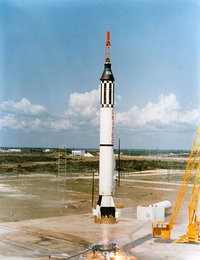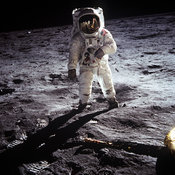|
The
National Aeronautics and Space
Administration (NASA),
which was established in 1958,
is the agency responsible for the
public space program of the United
States of America. It is also
responsible for long-term civilian and
military aerospace
research.
Vision
and mission
NASA's
vision is "to improve life here,
extend life to there, and to find life
beyond." Its mission is "to
understand and protect our home
planet; to explore the Universe
and search for life;
and to inspire the next generation of explorers."
History
- Space
race
For
additional background, please see the Space
Race article

May
5, 1961 NASA launches Mercury 3
capsule Freedom
7 Alan
Shepard Jr. first human flight
into sub-orbital space
Following
the Soviet
space program's launch of the
world's first man-made satellite (Sputnik
1) on October
4, 1957,
the attention of the United States
turned toward its own fledgling space
efforts. The U.S.
Congress, alarmed by the perceived
threat to American security and
technological leadership, urged
immediate and swift action; President Dwight
D. Eisenhower and his advisers
counseled more deliberate measures.
Several months of debate produced
agreement that a new federal agency
was needed to conduct all nonmilitary
activity in space.
On
July
29, 1958,
President Eisenhower signed the
National Aeronautics and Space Act of
1958 establishing the National
Aeronautics and Space Administration
(NASA). When it began operations on October
1, 1958,
NASA consisted mainly of the four
laboratories and some 8,000 employees
of the government's 46-year-old
research agency for aeronautics, the National
Advisory Committee for Aeronautics
(NACA).
NASA's
early programs were research into
human spaceflight, and were conducted
under the pressure of the competition
between the USA and the USSR
(the Space
Race) that existed during the Cold
War. The Mercury
program, initiated in 1958,
started NASA down the path of human
space exploration with missions
designed to discover simply if man
could survive in space.
On May
5, 1961,
astronaut Alan
B. Shepard Jr. became the first
American in space when he piloted Freedom
7 on a 15-minute suborbital
flight. John
Glenn became the first American to
orbit the Earth on February
20, 1962
during the 5-hour flight of Friendship
7.
Once
Mercury proved that human spaceflight
was possible, project
Gemini was launched to conduct
experiments and work out issues
relating to a moon mission. The first
Gemini flight with astronauts on
board, Gemini
III, was flown by Virgil
"Gus" Grissom and John
W. Young on March
23, 1965.
Nine other missions followed, showing
that long-duration human space flight
was possible, proving that rendezvous
and docking with another vehicle in
space was possible, and gathering
medical data on the effects of
weightlessness on humans.
Apollo
program
Following
the success of the Mercury and Gemini
programs, the Apollo
program was launched to try to do
interesting work in space and possibly
put men around (but not on) the Moon.
The direction of the Apollo program
was radically altered following
President John
F. Kennedy's announcement on May
25, 1961
that the United
States should commit itself to
"landing a man on the Moon and
returning him safely to the Earth"
by 1970. Thus Apollo became a program
to land men on the Moon. The Gemini
program was started shortly
thereafter to provide an interim
spacecraft to prove techniques needed
for the now much more complicated
Apollo missions.

Buzz
Aldrin walks on the surface of the
Moon during Apollo
11
After
eight years of preliminary missions,
including NASA's first loss of
astronauts with the Apollo
1 launch pad fire, the Apollo
program achieved its goals with Apollo
11 which landed Neil
Armstrong and Buzz
Aldrin on the moon's surface on July
20, 1969
and returned them to Earth safely on July
24. Armstrong's first words upon
stepping out of the Eagle
lander captured the momentousness
of the occasion: "That's one
small step for [a] man, one giant leap
for mankind." Twelve men would set
foot on the Moon by the end of the
Apollo program in December 1972.
NASA
had won the space race, and in some
senses this left it without direction,
or at the very least without the
public attention and interest that was
necessary to guarantee large budgets
from Congress. After Lyndon
Johnson left office, NASA lost its
main political supporter, and Wernher
von Braun was moved to a position
lobbying in Washington. Plans for
ambitious follow-on projects to
construct a space station, establish a
lunar base and launch a human mission
to Mars
by 1990
were proposed but with the end to
procurement of Saturn
and Apollo hardware there was no
capability to support these. The
near-disaster of Apollo
13, where an oxygen explosion
nearly doomed all three astronauts,
helped to recapture attention and
concern, but although missions up to Apollo
20 were planned, Apollo
17 was the last mission to fly
under the Apollo banner. The program
ended because of budget cuts (in part
due to the Vietnam
War) and the desire to develop a
reusable space vehicle.
Other
early missions
Although
the vast majority of NASA's budget has
been spent on human spaceflight, there
have been many robotic missions
instigated by the space agency. In 1962
the Mariner
2 mission was launched and became
the first spacecraft to make a flyby
of another planet in this case Venus.
The Ranger,
Surveyor,
and Lunar
Orbiter missions were essential to
assessing lunar conditions before
attempting Apollo landings with humans
on board. Later, the two Viking
probes landed on the surface of Mars
and sent color images back to Earth,
but perhaps more impressive were the Pioneer
and particularly Voyager
missions that visited Jupiter,
Saturn,
Uranus
and Neptune
and sent back science and color images
from all.
Having
lost the space race, the Soviet
Union had, along with the USA,
changed its approach. On July
17, 1975
an Apollo craft (finding a new use
after the cancellation of Apollo
18) was docked to the Soviet Soyuz
19 spacecraft. Although the Cold War
would last many more years, this was a
critical point in NASA's history and
much of the international co-operation
in space exploration that exists today
has its genesis here. America's first
space station, Skylab,
occupied NASA from the end of Apollo
until the late 1970s.
Shuttle
era
The
space
shuttle became the major focus of
NASA in the late 1970s and the 1980s.
Planned to be a frequently launchable
and mostly reusable vehicle, four
space shuttles were built by 1985.
The first to launch, Columbia
did so on April
12, 1981.
The shuttle was not all good news for
NASA flights were much more
expensive than initially projected,
and even after the 1986
Challenger
disaster highlighted the risks of
space flight, the public again lost
interest as missions appeared to
become mundane.
Nonetheless,
the shuttle has been used to launch
milestone projects like the Hubble
Space Telescope (HST). The HST was
created with a relatively small budget
of $2 billion but has continued
operation since 1990
and has delighted both scientists and
the public. Some of the images it has
returned have become near-legendary,
such as the groundbreaking Hubble
Deep Field images. The HST is a
joint project between ESA
and NASA, and its success has paved
the way for greater collaboration
between the agencies.

Space
Shuttle Columbia, April
12, 1981
In
1995
Russian-American interaction would
again be achieved as the Shuttle-Mir
missions began, and once more a
Russian craft (this time a
full-fledged space station) docked
with an American vehicle. This
cooperation continues to the present
day, with Russia and America the two
biggest partners in the largest space
station ever built the International
Space Station (ISS). The strength
of their cooperation on this project
was even more evident when NASA began
relying on Russian launch vehicles to
service the ISS following the 2003
Columbia
disaster, which grounded the
shuttle fleet for well over two years.
Costing
over one hundred billion dollars, it
has been difficult at times for NASA
to justify the ISS. The population
at large have historically been hard
to impress with details of scientific
experiments in space, preferring news
of grand projects to exotic locations.
Even now, the ISS cannot accommodate
as many scientists as planned.
During
much of the 1990s, NASA was faced with
shrinking annual budgets due to
Congressional belt-tightening in
Washington, DC. In response, NASA's
ninth administrator, Daniel
S. Goldin, pioneered the
"faster, better, cheaper"
approach that enabled NASA to cut
costs while still delivering a wide
variety of aerospace programs (Discovery
Program). That method was
criticized and re-evaluated following
the twin losses of Mars
Climate Orbiter and Mars
Polar Lander in 1999.
|